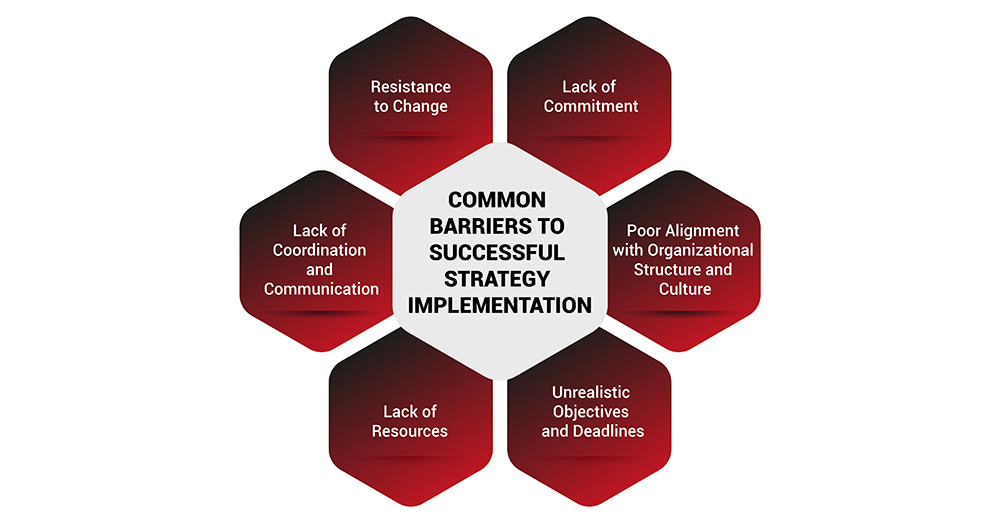Ensuring Strategic Success: Overcoming Common Barriers to Effective Strategy Implementation
 October 11, 2024
October 11, 2024
Developing a business strategy is only half the battle for a company - the real challenge lies in executing that strategy successfully. While having a well-designed strategic plan is important, it means little if an organization cannot execute that plan. This is where many businesses struggle, as effectively putting a strategy into action involves overcoming barriers that may impede progress.
In this article, we will explore some of the most common issues that can undermine a strategy's execution. Adopting the right approach to strategy implementation is key to achieving the strategic business success any organization aims for.
Common Barriers to Successful Strategy Implementation
Let’s explore the key obstacles that organizations often face when trying to execute their strategic plans.

-
1.
Lack of Commitment
One of the biggest barriers to effective strategy implementation is a lack of engagement to the strategic plan from leadership and employees. Without complete buy-in, it will be near impossible for an organization to follow through on the actions needed.
Senior leadership must demonstrate their dedication through both words and actions. They need to communicate the strategic priorities constantly and lead by example in focusing their own efforts to advance the plan. Employees will take their cues from the top - if leadership is not fully onboard, why should the rest of the company be?
It's also important for leaders to avoid a "check the box" mentality when it comes to strategic planning. While developing the plan requires significant effort, implementation demands sustained dedication over an extended period. Leaders must be willing to dedicate ongoing time and resources to ensuring the strategy's success rather than moving on to the next initiative.
To gain responsibility across all levels, the strategic planning process itself should engage employees. Involvement builds an understanding of why certain priorities have been set and a sense of contribution to the end goals. It helps employees feel invested in the strategy's success.
The best leaders approach implementation with evangelism, constantly communicating progress and emphasizing how individual roles connect to the overall vision. Their passion is contagious in driving devotion from others.
-
2.
Poor Alignment with Organizational Structure and Culture
A strategic plan will also flounder if there is misalignment with how an organization structures itself or the cultural norms that have developed. These act as barriers when they do not fully support what the strategy requires.
Assessing organizational fit should be part of strategy formulation. Leaders need to determine whether the current structure and processes will allow for efficient execution. Some level of realignment may be needed, such as reorganizing teams or centralizing certain functions to streamline decision-making.
Cultural norms can be more deeply ingrained and challenging to shift. Leaders must identify what values already exist that could help or hinder the strategy's success. An assessment can uncover assumptions, behaviors or risk appetites that may clash.
For instance, a strategic shift toward more aggressive growth targets could foster a risk-averse culture. Changing ingrained mindsets requires clear communication of "the why" behind cultural shifts and leadership modeling of new behaviors. It may take time to gain acceptance of adjustments to long-standing ways of working.
With both structure and culture, an incremental approach is wise. Asking for too much change too quickly risks destabilizing the organization when what is needed most is stability to focus on execution. Leaders should prioritize the most urgent areas of misalignment to address while maintaining functionality elsewhere. Gains over time through consistent reinforcement can achieve the necessary evolution.
-
3.
Unrealistic Objectives and Deadlines
Perhaps the surest way to doom a strategic plan is by establishing goals that are simply unattainable based on the organization's capabilities and market realities. Unrealistic objectives set the business up for certain failure and damage credibility in the process. They also frustrate employees tasked with achieving the impossible.
The solution lies in setting specific, measurable and time-bound (SMART) goals that strike a balance between ambition and achievability. Objectives should stretch the organization without being so aggressive that they become meaningless. Likewise, the timelines allotted for deliverables need to allow for probable challenges or setbacks rather than assuming a perfectly straight path.
Establishing this balance requires a hard look inward during strategic planning. Leaders need honesty about existing resources, competencies, competitive strengths and weaknesses. They must also factor in external risks and uncertainties that could affect outcomes in any time period. Scenario planning helps evaluate a range of possible scenarios to set responsible targets.
Goals should also have interim milestones to track progress, not just end dates. This enables course corrections as needed if realities diverge from initial assumptions. Linking incentives and accountability to milestones rather than just overall targets further motivates high performance throughout implementation.
Involving those responsible for execution in an objective-setting gives them a say in what is practically achievable too. Buy-in on objective setting leads to greater commitment when obstacles emerge during implementation. Uncompromising, unrealistic targets undermine credibility and morale if consistently missed.
-
4.
Lack of Resources
No strategic plan can come to fruition without allocating sufficient resources in money, people, systems, tools and capabilities. This represents another major barrier to success.
The resource needs of the strategic initiatives must be carefully evaluated against what is already available internally and what would require external sourcing to determine gaps. Simply hoping to "make do" with current funding and personnel is a recipe for strategic drift.
If resource shortfalls are significant, leaders have a choice to make. They can scale back certain strategic objectives to match what is realistically supportable. Alternatively, they must advocate for securing any additional funds, staff, technology or capital investments necessary from shareholders or other stakeholders.
Neglecting resource requirements courted implementation failure from the start. Leaders should be prepared to demonstrate clearly how strategic programs would create value justifying further resource allocations. They must also show prudent resource management plans to protect stakeholder investments.
People's capabilities are another area that requires advance consideration. Does internal talent match what new strategic directions call for? Are skills shortfalls better addressed through training existing staff or external hiring? With large capability gaps, programs may need to be redefined or their timetables extended to realistic training horizons.
-
5.
Lack of Coordination and Communication
Even when an organization has full alignment, resources and realistic objectives in place, the sheer complexity of implementing multiple strategic initiatives risks a lack of coordination as a barrier. Separate programs proceed independently rather than as an integrated whole.
To prevent this, establishing clear governance, coordination mechanisms and communication channels across all programs is vital. Strategic execution requires cooperation and alignment of effort as much as engagement to individual duties.
Program and project management best practices support this need. Methods like regular executive-level oversight, cross-functional teams owning integration points and centralized work management platforms help break down silos.
Communication keeps all teams continually updated on dependencies, shifts and inter-relationships so everyone understands their piece of the larger puzzle and can adjust accordingly. Regular reporting on progress, issues and resolution provides visibility and accountability too.
Top-down communication is also crucial for cascading priorities and rationales throughout the organization. Two-way communication collects frontline intelligence to identify weaknesses or opportunities in real-time for course corrections. Change fatigue necessitates concise, meaningful updates rather than overload.
With proper coordination, efforts across an organization synergize much more than their individual parts. Leaders must ensure information and effort flow as smoothly as capital to maximize strategic execution.
-
6.
Resistance to Change
Finally, as any strategic transformation aims to evolve an organization in some way, it meets the inherent resistance to change that exists in many people. Fear of the unknown, disruption to existing routines, perceived threats to job security - these can hamper buy-in or outright derail implementation.
To counteract change resistance, communication again plays a key role. Leaders must clearly articulate the rationale for change through its connection to strategic imperatives and intended benefits. They need to acknowledge honest concerns and alleviate uncertainties where possible
Training supports adaptation to change with skills development and vision for future roles. Leaders can also dampen resistance by granting employees genuine participation in shaping how changes are managed where practical.
Rather than battling change resistance directly, the wisest approach circumvents it. Leaders can build momentum and social proof by engaging early volunteers and eagerly championing a vision for success. Their passion is contagious to the unsure middle, lessening room for negativity to take hold.
Gradual pacing of change with intermediate goals also makes transformation less daunting by breaking it into smaller, more manageable steps. Consistency and follow-through reinforce that the change agenda is here to stay. The goal is a smooth evolution with people, not a forced revolution against them.
With understanding and sound change leadership, resistance can shift into acceptance, then commitment over time. The human side slows strategic implementation, but respecting it leads to longer-term sustainable results.
Conclusion
In conclusion, strategic execution presents many potential pitfalls that sap effectiveness if left unaddressed. Strong program and change management focused on overcoming these common barriers – from objective setting to resource allocation to internal buy-in – holds the secret to translating strategy into realized success.
With the right focus on these factors of alignment, environment, targets and communication, organizations can maximize their chances of achieving strategic objectives and long-term success.


